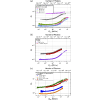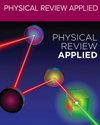五氧化二铌中的氧空位是超导铌中两级系统损耗的来源
IF 4.4
2区 物理与天体物理
Q2 PHYSICS, APPLIED
引用次数: 0
摘要
我们在由氧化铌组成的三维超导射频(SRF)谐振器和二维跨态子量子比特中发现了量子退相干的一个主要来源:五氧化二铌中的氧空位,它驱动了两级系统(TLS)损耗。通过使用 TOF SIMS 探测连续原位真空焙烧处理对块状铌 SRF 谐振器的射频性能和代表性铌样品的氧化物结构的影响,我们发现空腔品质因数 Q0 的非单调演化与 Nb2O5 空位生成和氧化物厚度降低的相互作用有关。我们将这种影响定位到氧化物本身,并通过湿氧化重新生长氧化物来说明扩散的间隙氧在底层铌中的作用微不足道,从而揭示了 TLS 损耗加剧的缓解过程。我们假设五氧化物中的这种空位是磁性杂质,是 TLS 驱动的射频损耗的来源。本文章由计算机程序翻译,如有差异,请以英文原文为准。

Oxygen vacancies in niobium pentoxide as a source of two-level system losses in superconducting niobium
We identify a major source of quantum decoherence in three-dimensional superconducting radio-frequency (SRF) resonators and two-dimensional transmon qubits composed of oxidized niobium: oxygen vacancies in the niobium pentoxide, which drive two-level system (TLS) losses. By probing the effect of sequential in situ vacuum-baking treatments on the rf performance of bulk SRF resonators and on the oxide structure of a representative sample using TOF SIMS, we find a nonmonotonic evolution of cavity quality factor , which correlates with the interplay of vacancy generation and oxide-thickness reduction. We localize this effect to the oxide itself and present the insignificant role of diffused interstitial oxygen in the underlying by regrowing the oxide via wet oxidation, which reveals a mitigation of aggravated TLS losses. We hypothesize that such vacancies in the pentoxide serve as magnetic impurities and are a source of TLS-driven rf loss.
求助全文
通过发布文献求助,成功后即可免费获取论文全文。
去求助
来源期刊

Physical Review Applied
PHYSICS, APPLIED-
CiteScore
7.80
自引率
8.70%
发文量
760
审稿时长
2.5 months
期刊介绍:
Physical Review Applied (PRApplied) publishes high-quality papers that bridge the gap between engineering and physics, and between current and future technologies. PRApplied welcomes papers from both the engineering and physics communities, in academia and industry.
PRApplied focuses on topics including:
Biophysics, bioelectronics, and biomedical engineering,
Device physics,
Electronics,
Technology to harvest, store, and transmit energy, focusing on renewable energy technologies,
Geophysics and space science,
Industrial physics,
Magnetism and spintronics,
Metamaterials,
Microfluidics,
Nonlinear dynamics and pattern formation in natural or manufactured systems,
Nanoscience and nanotechnology,
Optics, optoelectronics, photonics, and photonic devices,
Quantum information processing, both algorithms and hardware,
Soft matter physics, including granular and complex fluids and active matter.
 求助内容:
求助内容: 应助结果提醒方式:
应助结果提醒方式:


